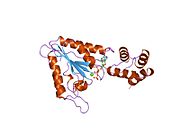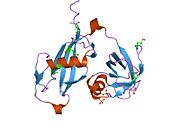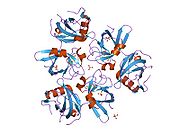- N-ethylmaleimide sensitive fusion protein
-
N-ethylmaleimide-sensitive factor, also known as NSF or N-ethylmaleimide sensitive fusion proteins, is an enzyme which in humans is encoded by the NSF gene.[1][2][3]
Contents
Function
NSF is a homohexameric AAA ATPase involved in membrane fusion.[4] NSF is ubiquitously found in the cytoplasm of eukaryotic cells. It is a central component of the cellular machinery in the transfer of membrane vesicles from one membrane compartment to another. During this process, SNARE proteins on two joining membranes (usually a vesicle and a target membrane such as the plasma membrane) form a tight complex. This aids fusion of the vesicle with the target membrane. It has been proposed that the role of NSF is to undo these SNARE complexes once membrane fusion has occurred, using the hydrolysis of ATP as an energy source, allowing the dissociated SNAREs to be recycled for reuse in further rounds of membrane fusion.[5] This proposal remains controversial, however. Recent work indicates that the ATPase function of NSF does not function in recycling of vesicles but rather functions in the act of fusing vesicles with the plasma membrane.[6]
SNARE hypothesis
Because neuronal function depends on the release of neurotransmitters at a synapse — a process in which synaptic vesicles fuse with the presynaptic membrane — NSF is a key synaptic component. Thus, conditional temperature-sensitive mutations in the Drosophila melanogaster gene for NSF lead to a comatose behaviour at the restrictive temperature (and hence the gene is called comatose), presumably because neuronal functions are blocked. In Dictyostelium discoideum amoebae, similar mutations lead to a cessation of cell movement at the restrictive temperature, indicating a role for intracellular membrane transport in migration. Another neuronal role for NSF is indicated by its direct binding to the GluR2 subunit of AMPA type glutamate receptors (which detect the neurotransmitter glutamate). This gives NSF a putative role in delivery and expression of AMPA receptors at the synapse.[7]
NSF was discovered by James Rothman and colleagues in 1987 while at Stanford University; they identified NSF after observing that a cytoplasmic factor, required for membrane fusions, was inactivated by treatment with N-ethylmaleimide. This assay enabled them to purify NSF.[8]
Interactions
N-ethylmaleimide sensitive fusion protein has been shown to interact with NAPA.[9][10]
References
- ^ "Entrez Gene: NSF N-ethylmaleimide-sensitive factor". http://www.ncbi.nlm.nih.gov/sites/entrez?Db=gene&Cmd=ShowDetailView&TermToSearch=4905.
- ^ Wilson DW, Whiteheart SW, Wiedmann M, Brunner M, Rothman JE (May 1992). "A multisubunit particle implicated in membrane fusion". J. Cell Biol. 117 (3): 531–8. doi:10.1083/jcb.117.3.531. PMC 2289450. PMID 1315316. http://www.pubmedcentral.nih.gov/articlerender.fcgi?tool=pmcentrez&artid=2289450.
- ^ Hoyle J, Phelan JP, Bermingham N, Fisher EM (November 1996). "Localization of human and mouse N-ethylmaleimide-sensitive factor (NSF) gene: a two-domain member of the AAA family that is involved in membrane fusion". Mamm. Genome 7 (11): 850–2. doi:10.1007/s003359900249. PMID 8875895.
- ^ Furst J, Sutton RB, Chen J, Brunger AT, Grigorieff N (September 2003). "Electron cryomicroscopy structure of N-ethyl maleimide sensitive factor at 11 A resolution". EMBO J. 22 (17): 4365–74. doi:10.1093/emboj/cdg420. PMC 202363. PMID 12941689. http://www.pubmedcentral.nih.gov/articlerender.fcgi?tool=pmcentrez&artid=202363.
- ^ Alberts, Bruce (2008). Molecular biology of the cell. Garland Science. ISBN 978-0-8153-4105-5.
- ^ Kuner T, Li Y, Gee KR, Bonewald LF, Augustine GJ (January 2008). "Photolysis of a caged peptide reveals rapid action of N-ethylmaleimide sensitive factor before neurotransmitter release". PNAS 105 (1): 347–52. doi:10.1073/pnas.0707197105. PMC 2224215. PMID 18172208. http://www.pnas.org/content/105/1/347.long.
- ^ Noel J, Ralph GS, Pickard L, Williams J, Molnar E, Uney JB, Collingridge GL, Henley JM (June 1999). "Surface expression of AMPA receptors in hippocampal neurons is regulated by an NSF-dependent mechanism". Neuron 23 (2): 365–76. doi:10.1016/S0896-6273(00)80786-2. PMID 10399941.
- ^ Glick BS, Rothman JE (1987). "Possible role for fatty acyl-coenzyme A in intracellular protein transport". Nature 326 (6110): 309–12. doi:10.1038/326309a0. PMID 3821906.
- ^ Barnard, R J; Morgan A, Burgoyne R D (Nov. 1997). "Stimulation of NSF ATPase activity by alpha-SNAP is required for SNARE complex disassembly and exocytosis". J. Cell Biol. (UNITED STATES) 139 (4): 875–83. doi:10.1083/jcb.139.4.875. ISSN 0021-9525. PMC 2139964. PMID 9362506. http://www.pubmedcentral.nih.gov/articlerender.fcgi?tool=pmcentrez&artid=2139964.
- ^ Hanson, P I; Otto H, Barton N, Jahn R (Jul. 1995). "The N-ethylmaleimide-sensitive fusion protein and alpha-SNAP induce a conformational change in syntaxin". J. Biol. Chem. (UNITED STATES) 270 (28): 16955–61. doi:10.1074/jbc.270.28.16955. ISSN 0021-9258. PMID 7622514.
Further reading
- Wilson DW, Whiteheart SW, Wiedmann M, et al. (1992). "A multisubunit particle implicated in membrane fusion". J. Cell Biol. 117 (3): 531–8. doi:10.1083/jcb.117.3.531. PMC 2289450. PMID 1315316. http://www.pubmedcentral.nih.gov/articlerender.fcgi?tool=pmcentrez&artid=2289450.
- Hanson PI, Otto H, Barton N, Jahn R (1995). "The N-ethylmaleimide-sensitive fusion protein and alpha-SNAP induce a conformational change in syntaxin". J. Biol. Chem. 270 (28): 16955–61. doi:10.1074/jbc.270.28.16955. PMID 7622514.
- Püschel AW, O'Connor V, Betz H (1994). "The N-ethylmaleimide-sensitive fusion protein (NSF) is preferentially expressed in the nervous system". FEBS Lett. 347 (1): 55–8. doi:10.1016/0014-5793(94)00505-2. PMID 8013662.
- Whiteheart SW, Rossnagel K, Buhrow SA, et al. (1994). "N-ethylmaleimide-sensitive fusion protein: a trimeric ATPase whose hydrolysis of ATP is required for membrane fusion". J. Cell Biol. 126 (4): 945–54. doi:10.1083/jcb.126.4.945. PMC 2120109. PMID 8051214. http://www.pubmedcentral.nih.gov/articlerender.fcgi?tool=pmcentrez&artid=2120109.
- Nagahama M, Orci L, Ravazzola M, et al. (1996). "A v-SNARE implicated in intra-Golgi transport". J. Cell Biol. 133 (3): 507–16. doi:10.1083/jcb.133.3.507. PMC 2120813. PMID 8636227. http://www.pubmedcentral.nih.gov/articlerender.fcgi?tool=pmcentrez&artid=2120813.
- Hoyle J, Phelan JP, Bermingham N, Fisher EM (1997). "Localization of human and mouse N-ethylmaleimide-sensitive factor (NSF) gene: a two-domain member of the AAA family that is involved in membrane fusion". Mamm. Genome 7 (11): 850–2. doi:10.1007/s003359900249. PMID 8875895.
- Jacobsson G, Meister B (1997). "Molecular components of the exocytotic machinery in the rat pituitary gland". Endocrinology 137 (12): 5344–56. doi:10.1210/en.137.12.5344. PMID 8940356.
- Timmers KI, Clark AE, Omatsu-Kanbe M, et al. (1997). "Identification of SNAP receptors in rat adipose cell membrane fractions and in SNARE complexes co-immunoprecipitated with epitope-tagged N-ethylmaleimide-sensitive fusion protein". Biochem. J. 320 ( Pt 2): 429–36. PMC 1217948. PMID 8973549. http://www.pubmedcentral.nih.gov/articlerender.fcgi?tool=pmcentrez&artid=1217948.
- Germain-Lee EL, Obie C, Valle D (1997). "NVL: a new member of the AAA family of ATPases localized to the nucleus". Genomics 44 (1): 22–34. doi:10.1006/geno.1997.4856. PMID 9286697.
- Subramaniam VN, Loh E, Hong W (1997). "N-Ethylmaleimide-sensitive factor (NSF) and alpha-soluble NSF attachment proteins (SNAP) mediate dissociation of GS28-syntaxin 5 Golgi SNAP receptors (SNARE) complex". J. Biol. Chem. 272 (41): 25441–4. doi:10.1074/jbc.272.41.25441. PMID 9325254.
- Lowe SL, Peter F, Subramaniam VN, et al. (1997). "A SNARE involved in protein transport through the Golgi apparatus". Nature 389 (6653): 881–4. doi:10.1038/39923. PMID 9349823.
- Barnard RJ, Morgan A, Burgoyne RD (1997). "Stimulation of NSF ATPase activity by alpha-SNAP is required for SNARE complex disassembly and exocytosis". J. Cell Biol. 139 (4): 875–83. doi:10.1083/jcb.139.4.875. PMC 2139964. PMID 9362506. http://www.pubmedcentral.nih.gov/articlerender.fcgi?tool=pmcentrez&artid=2139964.
- Osten P, Srivastava S, Inman GJ, et al. (1998). "The AMPA receptor GluR2 C terminus can mediate a reversible, ATP-dependent interaction with NSF and alpha- and beta-SNAPs". Neuron 21 (1): 99–110. doi:10.1016/S0896-6273(00)80518-8. PMID 9697855.
- McDonald PH, Cote NL, Lin FT, et al. (1999). "Identification of NSF as a beta-arrestin1-binding protein. Implications for beta2-adrenergic receptor regulation". J. Biol. Chem. 274 (16): 10677–80. doi:10.1074/jbc.274.16.10677. PMID 10196135.
- Subramaniam VN, Loh E, Horstmann H, et al. (2000). "Preferential association of syntaxin 8 with the early endosome". J. Cell. Sci. 113 ( Pt 6): 997–1008. PMID 10683148.
- Sagiv Y, Legesse-Miller A, Porat A, Elazar Z (2000). "GATE-16, a membrane transport modulator, interacts with NSF and the Golgi v-SNARE GOS-28". EMBO J. 19 (7): 1494–504. doi:10.1093/emboj/19.7.1494. PMC 310219. PMID 10747018. http://www.pubmedcentral.nih.gov/articlerender.fcgi?tool=pmcentrez&artid=310219.
- Allan BB, Moyer BD, Balch WE (2000). "Rab1 recruitment of p115 into a cis-SNARE complex: programming budding COPII vesicles for fusion". Science 289 (5478): 444–8. doi:10.1126/science.289.5478.444. PMID 10903204.
- Michaut M, Tomes CN, De Blas G, et al. (2000). "Calcium-triggered acrosomal exocytosis in human spermatozoa requires the coordinated activation of Rab3A and N-ethylmaleimide-sensitive factor". Proc. Natl. Acad. Sci. U.S.A. 97 (18): 9996–10001. doi:10.1073/pnas.180206197. PMC 27650. PMID 10954749. http://www.pubmedcentral.nih.gov/articlerender.fcgi?tool=pmcentrez&artid=27650.
- Imai C, Sugai T, Iritani S, et al. (2001). "A quantitative study on the expression of synapsin II and N-ethylmaleimide-sensitive fusion protein in schizophrenic patients". Neurosci. Lett. 305 (3): 185–8. doi:10.1016/S0304-3940(01)01844-4. PMID 11403936.
- Kittler JT, Rostaing P, Schiavo G, et al. (2001). "The subcellular distribution of GABARAP and its ability to interact with NSF suggest a role for this protein in the intracellular transport of GABA(A) receptors". Mol. Cell. Neurosci. 18 (1): 13–25. doi:10.1006/mcne.2001.1005. PMID 11461150.
PDB gallery 
This protein-related article is a stub. You can help Wikipedia by expanding it.





